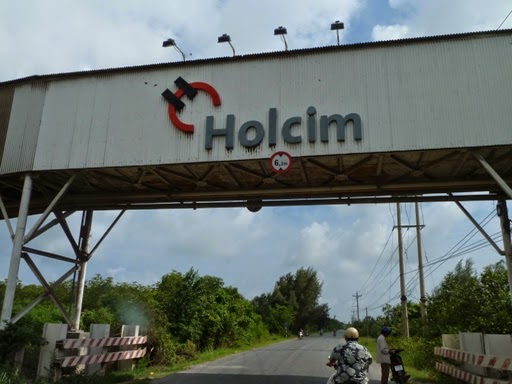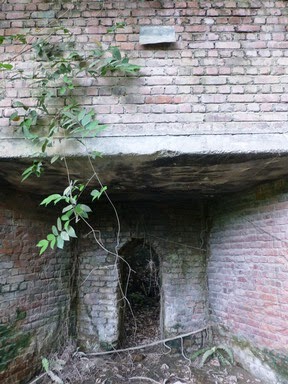Cement giants Lafarge and Holcim
There have been press reports earlier in 2014 that Holcim and Lafarge will merge. These are two of the world's cement giants. On April 7 2014 Holcim of Switzerland unveiled a deal to buy France's Lafarge, which would create the world's biggest cement maker, with $44 billion (26 billion pounds) of annual sales, and launch asset sales worldwide to steer it over antitrust hurdles. It will be known as LafargeHolcim.
Both these companies operate in southeast Asia. Both are destroying limestone hills.
Holcim is active in southwest Vietnam, in the controversial Ha Tien / Hon Chong area. I say controversial as this area is important for its biodiversity. One important document (in English) is "Beleaguered Hills: managing the biodiversity of the remaining karst hills of Kien Giang, Vietnam , (various authors / sponsors) 2008.
See my blog on Hon Chong.and FFI blog on Holcim
Lafarge are of course in Malaysia, currently quarrying Gunung Kanthan in Perak. See labels on right column of this blog, also the 2014 press reports.
Lafarge recently merged its British operations with those of Anglo American to form LafargeTarmac. Holcim runs Britain's Aggregate Industries.
Surprisingly the LafargeHolcim merger is already on Wikipedia.
Madagui, or “forest city”, is a bit of a misnomer as it is neither a forest in a city, nor a city in a forest. Madagui is, rather, an adventure park set inside a forest in southern Vietnam, between Ho Chi Minh City and the highland resort of Dalat.
Our reason for visiting Madagui was to explore the boulder caves. We were staying in the town of Tan Phu, so we took a bus to the park. Only it wasn’t a bus, it was a crowded van – it was already packed when it stopped to pick up our group of five! Somehow everyone managed to squeeze inside.
It was fun from the start. We got into an open safari truck – painted in tiger livery – and set off. Our driver went rather fast and it was a very bumpy ride as the roads were cobblestoned. I had to hang on tight every time we took a sharp corner.
We had a good overall view of the park area as we crossed the river and headed for the hills at the back, where the caves are located.
There are five caves open to the public. They are not limestone caves, but actually large gaps between enormous granite boulders. The boulders are really huge and you feel quite dwarfed when walking through its maze of passages.
Some passages are so dark that you need a torch. Wooden walkways and ladders ease one’s progress, but in many places there are small streams to step over.
It is a bit like something off a film set. The caves are situated in thick forests and the ginormous boulders forming the caves have huge tree roots entwined over them and creepers hanging down like strange curtains.
It was fun exploring the passages, following the marked trails, stepping over small babbling brooks.
There are legends associated with the caves. These stories originate from the Ma people, who inhabite the region and believe in a supreme protector of the forests. They say the caves were carved by the hands of the mountain spirit Yang Ndu who resides in the forest. Madagui according to the local language means “the Gui river of the Ma people”. The Ma are an ethnic minority belonging to the Mon-Khmer family who believe in animism and spirits.
Information boards in English and Vietnamese give details of the legends that are alive in this region.
At Than Nui deity park, large boulders outside Bat Cave and Heaven Blessing Cave have been carved to represent animal heads. These signify the animals that once gathered to listen to Buddha’s teachings. The bat and elephant, according to local beliefs, denote good genies that bring happiness and comfort.
Other animal heads that one would come across include the lion, buffalo, dragon, unicorn, tortoise and phoenix.
A group of stone bats “lead” visitors to the caves. In folklore, bats often appear as symbols of blessings, hence the name Heaven Blessing Cave. There are nine carved bats “flying” east to guide visitors to the main entrance of the cave. Then there is a carving of 18 bats in flight, descending on a tray of five fruits offered as a blessing. Inside the cave, an image of the bat-god extends towards you from the top of the dome, supposedly to bring wealth, luck and happiness to those who are sincere. (There used to be real bats living in the cave but they are no longer there.)
We were quite slow in exploring the caves and our driver decided our time was up, and asked if we wanted more time to walk to the last cave and then back to the headquarters. We opted for that.
It was a pleasant trek through the forest, on wooden planks and across several bouncy suspension bridges.
Death Cave was the last cave we visited. Not many people go there. A narrow trail passes mossy rocks and ladders lead down into the cave. Luckily the cave didn’t live up to its name and we emerged unscathed to walk back through a bamboo forest to the crocodile pond. There is a vast collection of bamboo in the park.
We reached the pond which was full of really large crocs basking in the hot sun. They looked like statues as they were totally inert, though I felt their beady eyes following us. Occasionally one would slide into the water with a very loud “plop”.
I giggled at the sign that said “crocodile fishing”. I imagined trying to catch one of these huge reptiles on a fishing line. The sign really meant that fishing was permitted. So presumably there must be fish there and they haven’t all been eaten by the crocs. Anglers can also try their luck fishing in the river, which is also used for rafting.
There are other activities to indulge in such as jet skiing, kayaking, motor boating, riding the banana boat and water duck biking!
For those who prefer dry land, you can try rock climbing, sliding down the zip line, target shooting, grass sliding and paintball.
Alternatively, you can go horse riding. Or go for a trek. There are streams in the forest with many secluded spots where you can enjoy a refreshing and cool swim.
If you want to go further into the jungle and mountains, you can go by jeep or UAZ, a Russian off-road vehicle.
Of course, you can just relax and have a picnic and enjoy the cool forest atmosphere. And after a hard day of fun, you can pamper yourself in the sauna and have a massage.
There is a variety of accommodation. For those who want comfort, there are three-star villas. If you are there with children, a more exciting option is sleeping in tents next to Tien Stream or in the “Tarzan-style” tree houses. These are situated in trees right by the river.
The large restaurant serves a variety of food, including local dishes of fish caught from the waters of the forest. Having a large variety of fruit trees means that some should be in season during your visit. You can go to the orchards which have the usual tropical fruits, as well as cooler highland varieties such as strawberries.
A popular night time activity is a jeep ride into the wildlife preserve. In this conservation area, you’ll find monkeys and deer, as well as muntjac and wild boar. Birds such as ostriches and pheasants and pretty fowls roam around too.
In fact, Madagui has an incredibly diversified ecosystem, with ancient trees and rare and valuable plant species. The nearby Cat Tien is a Unesco biosphere reserve and is home to large mammals, including the rare Javan rhino. It is very popular with bird watchers, too.
FACT FILE
Madagui,
Km 152, Highway 20,
Da Huoai District,
Lam Dong Province.
Email: reservation@madagui.com.vn
Entry to Madagui Forest City is VND40,000 (RM6) and all activities are priced separately.
Website: www.madagui.com.vn
> Madagui Forest is located in Lam Dong Province, 152km north of Ho Chi Minh City. It is situated right on the main highway, No 20, from Ho Chi Minh City to Dalat. Dalat is an old French hill station.
Getting there: From Ho Chi Minh City, take a bus that goes to Dalat, and get off at the forest city, about 7km after the town of Madagui. Alternatively, most travel agents in HCMC offer tours.
























